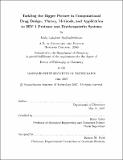Tackling the bigger picture in computational drug design : theory, methods, and application to HIV-1 protease and erythropoietin systems
Author(s)
Radhakrishnan, Mala Lakshmi
DownloadFull printable version (13.89Mb)
Other Contributors
Massachusetts Institute of Technology. Dept. of Chemistry.
Advisor
Bruce Tidor.
Terms of use
Metadata
Show full item recordAbstract
This thesis addresses challenging aspects of drug design that require explicit consideration of more than a single drug-target interaction in an unchanging environment. In the first half, the common challenge of designing a molecule that recognizes a desired subset of target molecules amidst a large set of potential binding partners is explored. Using theoretical approaches and simulation of lattice-model molecules, relationships between binding specificity and molecular properties such as hydrophobicity, size, and conformational flexibility were achieved. Methods were developed to design molecules and molecular cocktails capable of recognizing multiple target variants, and some were integrated with existing methods to design drug cocktails that were predicted to inhibit seven variants of HIV-1 protease. In the second half of the thesis, computational modeling and designs that were used to understand how cytokine binding and trafficking events affect potency are described. A general cellular-level model was systematically explored to analyze how signaling and trafficking properties can help dictate a cytokine-receptor binding affinity appropriate for long-term potency. (cont.) To help create an accurate cellular-level model of signaling and trafficking for one system in particular, the erythropoietin (Epo) system, we computationally designed mutant erythropoietin receptor (EpoR) molecules for use as experimental probes. By mutating a residue predicted to contribute to pH-dependent Epo-EpoR binding, reagents were designed to facilitate study of endosomal binding and trafficking. Furthermore, a pair of mutant Epo receptors was designed to form a specific, heterodimeric complex with Epo to facilitate study of each individual EpoR's role in signaling via the asymmetric Epo-(EpoR)2 complex.
Description
Thesis (Ph. D.)--Massachusetts Institute of Technology, Dept. of Chemistry, 2007. This electronic version was submitted by the student author. The certified thesis is available in the Institute Archives and Special Collections. Includes bibliographical references.
Date issued
2007Department
Massachusetts Institute of Technology. Department of ChemistryPublisher
Massachusetts Institute of Technology
Keywords
Chemistry.